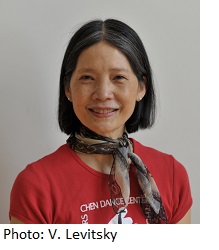
 It's been five years since a raging fire tore through 70 Mulberry Street, a historic building in New York City, destroying the home of the Chen Dance Center, a respected modern dance company and school with deep roots in Chinatown.
It's been five years since a raging fire tore through 70 Mulberry Street, a historic building in New York City, destroying the home of the Chen Dance Center, a respected modern dance company and school with deep roots in Chinatown.
Since then, Dian Dong, the center's co-founder and associate director, has worked to continue the mission she and her creative partner and husband Hsueh-Tung (H.T.) Chen started almost 50 years ago—to keep the center a cultural hub that raises awareness of the Asian American struggle through dance.
It hasn't been easy. One month after the fire, COVID devastated Chinatown's economy. And then two years later, H.T. died of lung cancer.
Dong says it could take until 2027 before the building is restored and the company can move back in. But that's not slowing her down. In January, her dance company rang in the Lunar New Year with revivals of Opening the Gate and Mott Street, two pieces that celebrate the resilience of Chinatown's residents. And the company has held many workshops and performances at schools and institutions nationwide.
The resilience that Dong often celebrates in her community is clearly her own, too. A fifth-generation Chinese American, Dong was born in Sheepshead Bay, Brooklyn, and lived there until her family moved to Bergenfield, NJ, when she was four. At the time, they were the only Chinese family in the area, and it was a culture shock. "I didn't fit in because I was so scrawny and shy," says Dong. "You don't feel it as much in elementary school, but when you get to junior high school, you realize how different you are and become very self-conscious."

Dong's passion for dance started young. She remembers choreographing her own moves at age three. It didn't take long for her parents to recognize her talent and sign her up for ballet classes with Vladimir Dokoudovsky and modern dance with Shirley Ubell.
Dong went on to study at Juilliard, thanks to her mother's encouragement. "My mom opened the Sunday newspaper in 1969, and there was a big article about the Juilliard School joining the campus of Lincoln Center," says Dong. "She said, 'Why don't you go there? They have a dance department.'" She auditioned and was accepted as Juilliard's first Chinese female student—with a full scholarship.
It was at Juilliard where Dong met Chen--who recently arrived from Taiwan--and together they shared a passion for social justice and dance.
"The question of identity always haunted me because our elders didn't want us to know about the hardships they endured,” says Dong, whose great-great-grandfather came to the U.S. in the 1800s. "Dance has given me a voice and a purpose and allowed me to pursue my passion while honoring our ancestors and educating others about the Chinese American experience.”
We spoke to Dong about her meaningful work with H.T., rebuilding after loss, and finding her voice as an Asian American artist.
Where did your love of the arts come from?
My parents were very creative. They were both visual artists who adopted five children so they were very liberal minded. My mother did oil paintings and pastels and taught free art classes to senior citizens for 30 years. My dad was a watercolorist but worked as an industrial designer and inventor who took out 17 different patents in his lifetime.
It sounds like an idyllic childhood.
We were the happiest kids because even though we were all adopted, we were given such great opportunities.
I was the first Chinese woman to attend the Juilliard dance program; my brother was the first one from Bergenfield, NJ, to go to Harvard; my other brother went to Yale and then Harvard; another brother went to George Washington University; and my other brother—he liked to watch television—and I always wondered why my parents let him watch television, but guess what? He became a top television cameraman for Channel 13's the MacNeil/Lehrer Newshour.
My parents told us we had to choose one thing that made us happy and to stick with it. It was amazing what they did with such little money.
What was it like as an Asian woman pursuing dance in the 70s?
My parents knew that I loved dance, but in my generation dance was like being a prostitute. Good girls did not dance. I was surprised by how welcoming the instructors were. I worked hard and took to dancing easily—they appreciated that. I also had some amazing teachers who gave me scholarships. One teacher looked outside the window and saw my Chinese parents waiting for me in a station wagon with my brothers and said, "I figured you needed a scholarship."

Tell us how you and H.T. met at Juilliard.
While there, Martha Hill (Juilliard's founding director of the dance division) asked me to act as a translator for an auditioning student. It was H.T., and he spoke Mandarin, but I didn't. I told the faculty, "I don't think we speak the same language," and someone said, "Well, that's nice, dear. Now ask him..." She wasn't even listening to me.
So how did you communicate?
Sometimes it was like sign language and pantomime. I realized it was all a ploy from the director of the dance department because I was the first Chinese woman in the Juilliard dance department and H.T. was the first Chinese male.
I guess one thing led to another in the romance department?
I ended up helping H.T. with his homework on weekends and evenings--and we fell in love. I had never dated or had a boyfriend. We were married for 47 years.
It must have been an extraordinary experience to study at Juilliard with some of the very best.
We studied American dance—ballet and modern dance—with the top people. Antony Tudor was the head of the ballet division, and he taught people like (ballet dancers) Alfredo Corvino and Hector Zaraspe. (Dancer and choreographer) Jose Limon taught my freshman year.
So how did you and H.T. wind up fascinated by Chinese Americans and their role in U.S. history?
It was the 70s, and I had just graduated from Juilliard, while H.T. went on to get his master of arts in dance education at NYU. We were poor as church mice, living in the West Village in a fifth floor walkup for $60 a month. At the time, H.T. thought this was in the land of freedom, but one of the first things he saw was Chinese senior citizens wearing placards and protesting in the streets. He was also shocked to see Chinese American garment workers striking. That's how he started investigating the real history of Chinese in America.
What was his reaction to what he saw?
H.T. felt so bad when he saw people protesting against low wages and trying to unionize. He felt that he didn't know enough about America, so he applied for a grant to do research on Angel Island (the mainly Asian Ellis Island of the West). We went to the West Coast to research and talk to elders, and then we went to Mississippi to talk to Chinese living in the South. I remember asking, "Why would we go? There are no Chinese there." And sure enough, we found this whole community of Chinese with southern accents who had lived for generations in rural Mississippi and Tennessee. That's how we created the [performance] South of Gold Mountain.
They must have had quite an impact on you and H.T. to inspire a dance devoted to them?
When we flew down, there were so many Chinese people who were happy to see us northerners. They invited all of their friends to come over, and they brought photo albums with sepia colored photographs of them at the turn of the century doing all kinds of manual farm labor. A lot of them went there to build canals in Georgia following their work on the transcontinental railroad. Because the Delta Region had very fertile soil and warm weather, very much like southern China, they thought it was wonderful for farming, so a lot of them stayed in the area. They thought it was hilarious when H.T. said he was going to create a dance about them.
You're a fifth-generation Asian American. How did you end up devoting your life to telling the Chinese immigrant experience if you didn't go through it yourself?
In a way, we did come from that, but my parents wanted us to get away from that. They would ask why we focused on garment workers. I understood the need to highlight these hard working, honest people. These were untold stories that deserved to be shared.
What kind of responses did you get?
Everyone thought H.T. was crazy for being a barefooted Chinese male modern dancer wearing black and sliding around on the floor. The Chinese would ask "Why would you want to dance?" and "Why can't you show us something high class? Not workers in the garment industry or in restaurants." But we thought pieces about Chinese in America were beautiful.
Did you and H.T. bring different things to the partnership?
H.T. was the idea, man—and I made it happen. I'm still in charge of education programming, and my older daughter is in charge of management and the logistics of touring.

Is dance the most satisfying form of expression for you?
Absolutely. Through dance, you can really tell the truth without words, and people feel it no matter what their age. Dance is an immersive experience where you see the action building. In our performance Hidden Voices, [based on the 1870s Chinese strikebreakers at a shoe factory in North Adams, MA] children and adults break into applause when they see the dancers working the machines, fighting with the local workers, and then suddenly throwing their work aprons away. The labor strike was resolved after three and a half years, and the audience sees a circle of unity. North Adams remained a hub for shoe factories until the 1960s. When I tell the audience these facts, they understand the value of immigrants in labor history, and they don't see us as taking away new jobs. They remember our performance, they feel deeply about it, and they write us fan letters.
Tell us about the Tracing Footsteps remote learning dance curriculum that you created for New York City kids.
In 2021, H.T. and I created a K-12 lesson plan for the New York City Department of Education in collaboration with the Dance Education Laboratory. "Into the Heart of Chinatown took us a whole year and includes video tutorials, video clips of dances, and study guides aimed at increasing awareness and understanding of the Asian American experience through dance—and it's free for any school nationwide.
You have a theater and a dance school, and you host many workshops and assemblies around the country. But why is your dance company so core to what you do?
It's really important that the company exists because when you show up in person and do a live performance, people respond to it. I can get 500 kids and teachers so passionate that they're applauding and participating; they remember and they feel deeply about it. It helps people understand who we are and our role in a very important part of the American story.
Are you still holding dance classes for kids and teens?
We no longer have a space in Chinatown, and I can't afford commercial rental space so we only offer Zoom classes and Early Childhood classes at a local school.
What are you working on now?
Last fall we toured colleges including UMass, Amherst, Williams College, NYU, and Montclair State University. But we aim to reach all ages. We're going to schools, colleges, and all organizations interested in seeing us because when a whole community sees a performance, they go home, talk about it, and learn together.
How has Chinatown changed since you started working there decades ago?
Until the fire, Chinatown was really building up more arts programming. The community is doing a wonderful job with visual and performing arts. But the pandemic really has taken a big toll on progress. I hope Chinatown will rebound.
What's the impact of art on your life?
Life is short, but art is long. I feel like my whole life has been dedicated to the arts. It's not just the art of dancing; it's the art of being a human. That's my authentic voice, and that's all I really live to do. I just want to connect to people--to have them more empowered and more connected. There is nothing greater than understanding and building community.
_______________________________
*Edited for length and clarity
Cover photo: V. Levitsky
Photo: Images provided by Dian Dong and The Chen Dance Center
Trump’s Team Cited Safety in Limiting Covid Shots. Patients, Health Advocates See More Risk.
by Stephanie Armour
Jade Pieces: Superb Sunscreens
Picture This: API Mental Health Statistics
How to Report Hate Crimes Against AAPIs
Who, What, Where and How: AAPI Organizations

